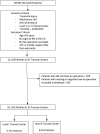Factors associated with optimal patient outcomes after operative repair of isolated hip fractures in the elderly
- PMID: 33376809
- PMCID: PMC7757513
- DOI: 10.1136/tsaco-2020-000630
Factors associated with optimal patient outcomes after operative repair of isolated hip fractures in the elderly
Abstract
Background: Increased time to operative intervention is associated with a greater risk of mortality and complications in adults with a hip fracture. This study sought to determine factors associated with timeliness of operation in elderly patients presenting with an isolated hip fracture and the influence of surgical delay on outcomes.
Methods: Trauma quality collaborative data (July 2016 to June 2019) were analyzed. Inclusion criteria were patients ≥65 years with an injury mechanism of fall, Abbreviated Injury Scale (AIS) 2005 diagnosis of hip fracture, and AIS extremity ≤3. Exclusion criteria included AIS in other body regions >1 and non-operative management. We examined the association of demographic, hospital, injury presentation, and comorbidity factors on a surgical delay >48 hours and patient outcomes using multivariable regression analysis.
Results: 10 182 patients fit our study criteria out of 212 620 patients. Mean age was 82.7±8.6 years and 68.7% were female. Delay in operation >48 hours occurred in 965 (9.5%) of patients. Factors that significantly increased mortality or discharge to hospice were increased age, male gender, emergency department hypotension, functionally dependent health status (FDHS), advanced directive, liver disease, angina, and congestive heart failure (CHF). Delay >48 hours was associated with increased mortality or discharge to hospice (OR 1.52; 95% CI 1.13 to 2.06; p<0.01). Trauma center verification level, admission service, and hip fracture volume were not associated with mortality or discharge to hospice. Factors associated with operative delay >48 hours were male gender, FDHS, CHF, chronic renal failure, and advanced directive. Admission to the orthopedic surgery service was associated with less incidence of delay >48 hours (OR 0.43; 95% CI 0.29 to 0.64; p<0.001).
Discussion: Hospital verification level, admission service, and patient volume did not impact the outcome of mortality/discharge to hospice. Delay to operation >48 hours was associated with increased mortality. The only measured modifiable characteristic that reduced delay to operative intervention was admission to the orthopedic surgery service.
Level of evidence: III.
Keywords: health care; hip fractures; mortality; outcome assessment; quality improvement.
© Author(s) (or their employer(s)) 2020. Re-use permitted under CC BY-NC. No commercial re-use. See rights and permissions. Published by BMJ.
Conflict of interest statement
Competing interests: None declared.
Figures
References
-
- Tignanelli CJ, Joseph B, Jakubus JL, Iskander GA, Napolitano LM, Hemmila MR. Variability in management of blunt liver trauma and contribution of level of American College of surgeons Committee on trauma verification status on mortality. J Trauma Acute Care Surg 2018;84:273–9. 10.1097/TA.0000000000001743 - DOI - PubMed
Grants and funding
LinkOut - more resources
Full Text Sources
Research Materials


